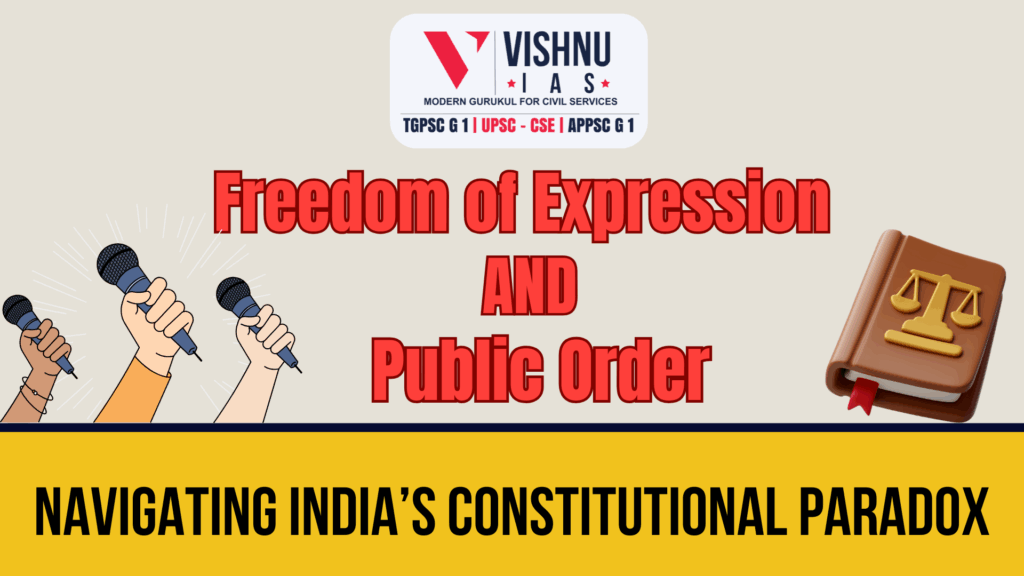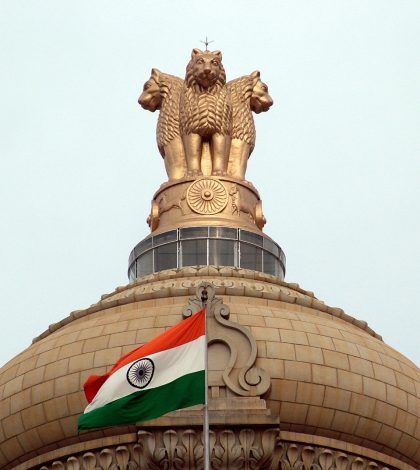Freedom of Expression and Public Order: Navigating India’s Constitutional Paradox
Introduction
Freedom of speech and expression is a cornerstone of India’s democracy, enshrined in Article 19(1)(a) of the Constitution. However, the reality of law and politics often diverges from this ideal. Liberal norms of free expression are frequently undermined by justifications for curbing dissent. The tensions between freedom and restriction are evident in constitutional provisions, judicial precedents, and recent controversies like the Pahalgam case.
Constitutional Guarantees vs. Restrictions
Broad Freedom and Narrow Restrictions
- Article 19(1)(a) of the Indian Constitution guarantees the right to freedom of speech and expression, a liberty described by the Supreme Court in Romesh Thappar v. State of Madras (1950) as “the matrix of all freedoms.” However, Article 19(2) qualifies this right by permitting “reasonable restrictions” in the interests of sovereignty, security, public order, decency, morality, defamation, and other factors.
Historical Context and Evolution
- In the 1950s, the First Amendment to the Constitution expanded the grounds for restricting speech, introducing categories like “public order” and “friendly relations with foreign states.” This amendment marked a pivotal moment where socio-economic reforms and political control often took precedence over free expression. Palshikar aptly describes this as the beginning of India’s tradition of using legislative and judicial tools to stifle dissent under the guise of public interest.
Judicial Precedents on Free Speech
The Kedarnath Singh Case: Defining Sedition
- In Kedarnath Singh v. State of Bihar (1962), the Supreme Court upheld the constitutionality of the sedition law (Section 124A of the IPC) while narrowing its scope. It ruled that only speech inciting violence or public disorder could be considered seditious. Despite this high bar, sedition charges have multiplied in recent years, often targeting critics without evidence of incitement.
Shreya Singhal v. Union of India: Striking Down Vague Laws
- In Shreya Singhal v. Union of India (2015), the Court struck down Section 66A of the IT Act for being overly broad and vague. This landmark judgment reaffirmed that laws must not have a chilling effect on public discourse and must fit within the permissible restrictions of Article 19(2).
Mixed Signals from the Judiciary
- While the judiciary has occasionally acted as a guardian of free speech, its record is inconsistent. For instance, it refused to bar warrantless sedition arrests in 2016 but later quashed frivolous cases like those involving public figures. The gap between judicial pronouncements and on-ground enforcement remains a concern.
Selective Enforcement and the Pahalgam Case
Uneven Application of Laws
- The Pahalgam terror attack in May 2025 exposed glaring double standards in the enforcement of free speech laws. A citizen who critiqued government policy was swiftly arrested and investigated, while another individual making inflammatory remarks faced less severe consequences. Such selective enforcement undermines public trust in the impartiality of the state.
Broader Patterns of Misuse
- The Pahalgam case is not an isolated incident. Activists and journalists often face sedition or anti-terror charges for dissenting against the government, while comparable statements by ruling-party supporters go unpunished. This misuse of legal instruments erodes faith in the state as a neutral guarantor of rights.
The Security–Liberty Tension
- Balancing National Security and Civil Liberties
- The tension between security and liberty is a perennial challenge for liberal democracies. India’s legal framework permits restrictions on free speech in the interest of national security, but these provisions are often used to silence dissent. The broad application of laws like UAPA and sedition serves as a tool for political intimidation rather than genuine threat mitigation.
Procedural Safeguards and Jurisdictional Confusion
- India’s courts have emphasized that restrictions must be narrow and precise. However, procedural lapses, such as FIRs filed without merit or arrests made without due process, often precede judicial intervention. This highlights the need for institutional safeguards, such as requiring judicial or senior police approval before initiating cases under sedition or anti-terror laws.
Safeguarding Free Speech in a Liberal Democracy
Clarity and Precision in Laws
- Vague and overbroad laws like Section 66A of the IT Act invite misuse. Courts must continue interpreting restrictions narrowly, and Parliament should resist reintroducing draconian statutes. Public interest litigation and transparency in prosecutions can help expose patterns of abuse.
Strengthening Institutional Safeguards
- The state’s monopoly on defining speech boundaries must be balanced by independent institutions. Pilot court schemes for reviewing sedition cases and legislative measures requiring prior sanction for prosecutions could reduce frivolous cases. The judiciary must also take proactive stances rather than offering relief only after violations occur.
Cultural and Political Commitment to Open Debate
- Liberal democracy thrives on a culture of dissent and dialogue. Political parties must uphold free speech consistently, irrespective of whether they are in power. Public discourse should prioritize debate over censorship, and educational institutions should instill an appreciation for diverse viewpoints.
Learning from International Norms
- India can benefit from engaging with international frameworks like the Universal Declaration of Human Rights and learning from other democracies’ experiences with hate speech and social media regulation. Global best practices can inform domestic reforms and strengthen protections for free expression.
Conclusion
The Pahalgam case and similar incidents reflect a broader “illiberal mirror” where India’s democratic ideals are often distorted by fears of terrorism, cultural majoritarianism, and political partisanship. Upholding freedom of expression requires uniform application of the rule of law and narrow, transparent limits on speech. Trust in a robust democracy grows when citizens see the same rules applied to all, regardless of their political or social standing. Managing the tension between security and liberty without compromising democratic principles is the ultimate test for a truly free society.


